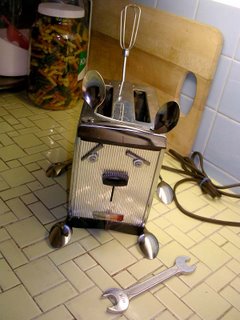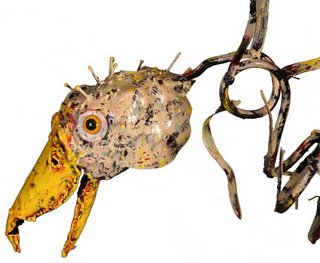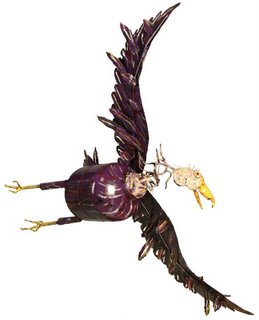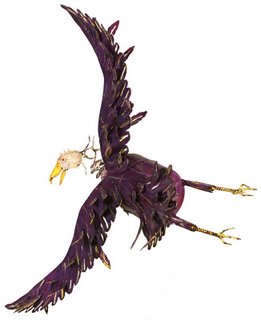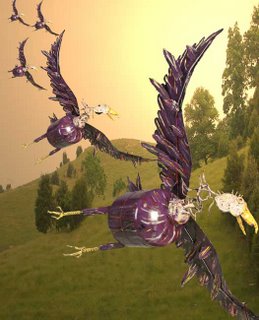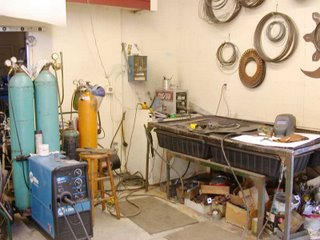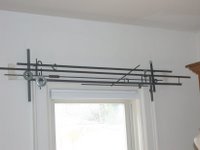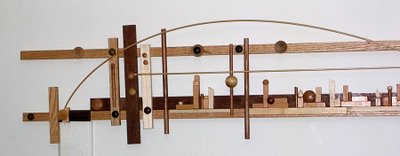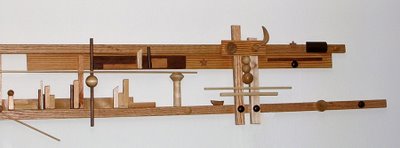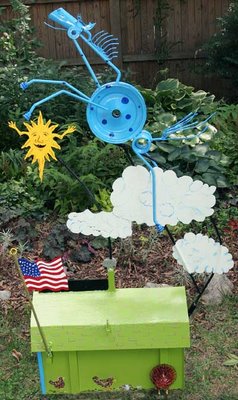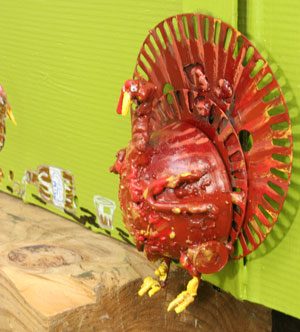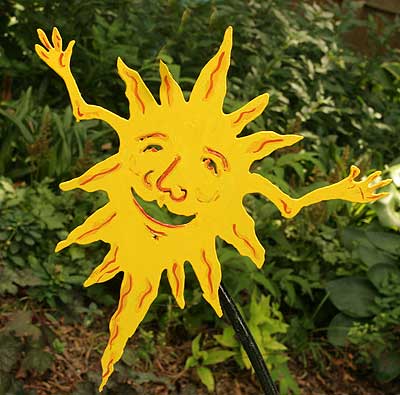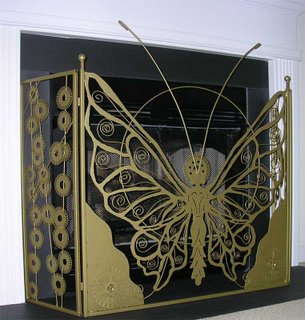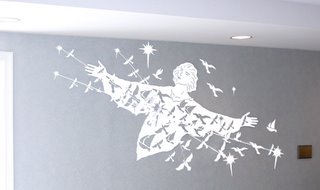
My new wall sculpture, "Liberation," was installed at Glen Aire Presbyterian Retirement Home in Cary, NC Friday.
It's cut in 19 gauge steel and painted with white enamel. The piece measures 6 ft 6 inches wide ( 1.95 meter) by approximately 4 ft high (1.20 meter). The steel lines coming bending out from the all, represent latitudinal lines such as found on a globe or map. The lines project out about 1 ft from the wall (30 cm) (click on photo to see enlargement)
The color of the piece is actually a vivid white, but the peculiar blue gray wall covering behind the piece seems to have confused my camera a great deal.
The woman in the sculpture is dissolving into the many birds, boats, stars, leaving the retirement home in spirit and dreams if not in her body.
One of the pleasures of doing commissioned art work is telling people's stories. By that I mean I always ask a potential client what they want a piece to do or say about them. For me, a commissioned piece of art work is a person asking me to tell the emotional essence of one of their favorite stories. Sometimes, I don't know the whole story myself until the piece is finished and the client sees it.
That was certainly the case here.
I have known Mr. Davis (not his real name) nearly my entire life. He was simply one of the members of the constellations of adults a child vaguely senses around him and deals with. In this case, Mr. Davis was one of the men at our Presbyterian church when I was growing up. He was Alex and Mary's dad, and sometimes he was an usher at the 11 AM service and his wife was the church secretary and he served on the church boy scouts troop committee along with my father.
I was surprised to hear from him late last year. He called me up out of the blue telling me he wanted to commission a sculpture for a new area being built in the retirement community where he had moved some years before. He could not articulate why he wanted to commission a sculpture. Pressed, he said he had seen a sculpture in a doctor's office that had moved him and he wanted one like that. I explained I had no interest in copying another artist's work and was pretty sure the copyright laws were against it, too. But, this was so out of character for Mr. Davis I was intrigued. What had moved him so much about the sculpture he had seen? I asked him to think about what he wanted this sculpture to say? When he could tell me that, I said, we could start to talk.
I met him and his daughter, Mary, several weeks later at the retirement home. I was surprised to find, Betty, his wife, was suffering from dementia and Alzheimer's--"we moved here years ago after Betty was diagnosed," Mr. Davis explained. He had seen the sculpture that moved him on one of the numerous trips to a doctor's office whenever he took his wife for treatment.
"Daddy has taken what you said about considering what this means very seriously," Mary told me. "He's called everybody in the family and everybody has told him it's his project and nobody can tell but him."
"So what's this sculpture to be about?" I asked Mr. Davis.
"I think it's about liberation," he said. I was surprised at how his voice quavered, how emotional he seemed. Men of my father's generation, WWII vets, never showed that.
I did not want to risk embarrassing him by probing further. "I can work with that theme," I assured him, and steered the discussion into safer waters such as costs, schedules, and contracts, all familiar territory to Mr. Davis, a man who'd spent his career as a purchasing accountant for a large manufacturing plant.
Over the next several months, I had several frustrating false starts on some designs I was not happy with and the new building in which this was to be installed was delayed. Finally, I came up with a design I presented to Mr. Davis and his daughter.
I worked from a comment my own grandfather made to me when he was 80 and I was in my early 20s. "Joel, I don't think or feel much different than you do, I just don't get around as fast."
I added to that, the fact that the average age of residents at this retirement community is 82 and that three fourths of them are women.
From those ideas, I designed a figure of a young woman dissolving into birds, boats, stars, all symbols of freely going one's own way or direction in the universe. I designed steel rods, much like latitude and longitude lines on a globe or map to come out and surround the figure, they also provide support for the various figures of birds and boats cut from the figure of the woman.
Mr. Davis had one other request about the design when he saw the full sized paper model, could there be a small plaque to one side giving the title of the piece, my name, the date, and --he was quite specific about this, in much smaller letters, "A gift of Robert and Betty Davis."
Well, I finally got the piece finished and the retirement community got their building done. Friday, I went out there to install the piece. Several of the staff were on hand to help as well as Mr. Davis. When they saw the sculpture had been designed to be light weight and in pieces, Mr. Davis volunteered to help put it up and sent the staffers on their way.
When we were nearly finished, I was sorting and putting away extra screws and drill bits. Mr. Davis was staring at the sculpture and commented, "There's nothing else like it here. I'm sure Betty would be pleased."
Just to pass the time, I asked him where and when he and Betty had met. That's when I got the real story of the "Liberation" sculpture.
"We met in the fall of 1943 in the most exciting city in the world for young people in wartime-- San Francisco." I was struck by this just-the-facts-business man's sudden turn of poetic phrase.
"I'd just graduated from college and was newly commissioned in the US Navy as an ensign. I was sent to San Francisco to meet my ship. When I arrived, the harbor master told me it would not be in port for months--- I would have to apply for some temporary assignment until it arrived. Assigned a 5PM to 3 AM shift in a downtown office building proof reading code book revisions, I soon noticed a very pretty WAV worked the day shift on a different floor. Given our schedules and locations, I had little hope of getting to know her. Her supervisor, an ensign in the WAVs, had taken an, ahem, "personal" interest in me, though, and she arranged to have me transferred to her department and shift. She had no idea Betty was in the picture for me. It wasn't long before Betty and I were an item and we knew we were meant to be. I left San Francisco in March of 1944, an officer on a freighter carrying 8500 tons of high octane aviation gas bound for the South Pacific. The ship returned to San Francisco in May, 1945 and we became engaged the following month on her birthday. When the ship put to sea again, Betty and I planned to be married when the ship returned to San Francisco.
We were at sea 19 months, saw a lot of boredom and a bit of combat, including three landings. Betty and I wrote the whole time. I still have all our letters. Maybe our kids will be interested in them some day. They don't have any literary value, just an account of two young people in love and lot of boring information about life on board my ship.
Anyway, I got a letter from Betty one day saying she was so excited I would be coming home soon. Surface mail to my APO address had been cut off some weeks before and she was sending this letter via air mail on the last day allowed for my address. That must mean our ship was coming back. The same day I got that letter, our ship got orders canceling our return to San Francisco and ordering us to proceed around Africa and on to New York City. There, our ship was to be decommissioned. With our mail cut off, there was no way to let Betty know. For a long time, she had no idea where I was or how I was.
Once I reached port and contacted Betty, she did manage to get to New York, though it was a long train ride in those days. We got married in a small Episcopal church in the theater district, called The Little Church Around the Corner. New York was full of servicemen in those days and housing was tight. After the wedding, I managed to rent a room at the Ritz Carlton for three nights. The rate was $10/night but for people in the service there was a 25 % discount, so we paid just $7.50/night.
To get a Stateside billet, you needed a certain number of points, accrued in serving overseas. I knew I didn't have enough points to qualify. Meeting with the re assignment officer, I explained I had just gotten married the day before, and that I knew I didn't qualify for a stateside assignment, but my wife had a large apartment in San Francisco--- could he assign me to a ship home ported there? He was sympathetic and said sure. Just to make things nicer, he asked me where I'd like to pick my orders to San Francisco? I replied, I thought I would sure like to pick them up in Miami. He then ordered me to proceed to Miami to pick up my orders for re assignment, so the Navy at least picked up the transportation tab for our honeymoon. From Miami, we traveled to San Francisco and I served on a passenger liner bringing troops home from the war. Betty mustered out of the WAVs and got a job as a clerk in San Francisco.
When the navy let me go in '47 I got a job with a company that owned a plant in Raleigh and we've lived in the area ever since.
Returning to my truck, Mr Davis and I paused at the main hall entrance and he motioned to the glass case of photos of residents in their WWII uniforms. There had been a contest to see who still looked the most like their old photo. "I have a photo of Betty in her WAV uniform," he said, "but I wouldn't put it in here with the other women. Not fair. She was a lot prettier than they were."
They have been together 63 years, but the last ten years, she's been slipping away from him, parting them for far longer than the war ever did. Back then, they could write, but now there is no letter he can write that she can read or ever respond to.
He has lunch with her every day.
He sees her in the morning and helps nurses tuck her in at night.
Still, they are parted more sternly than the vagaries of war ever did. You cannot write to a mind that has slipped below the sunset of Alzheimer's.
He is like a man putting messages in a bottle thrown in the sea. As long as there is any chance of a last letter reaching that pretty young woman so far away he will write.
He writes to her now by simply being there, touching her, by saying "Good Morning." or "I love you." Maybe one will get through. He never knows.
But she waited for him, and he, by God, will wait for her.
Until their liberation.








